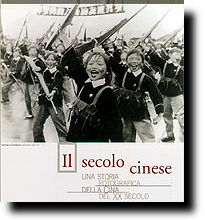At the beginning of the 20th century China was still like it was as it is described in documents of the 3rd century B.C. With a territory that was almost as large as the United States, it not only had extensive deserts but also tropical areas as well as more temperate zones. Its inhabitants were mostly farmers, their lives were ordered according to the seasons and small villages grew up near the great markets of the cities. People were only able to speak the dialect of their own particular province, unintelligible to others, and nobody would have even imagined that great political, social and economic changes were soon to come about in the country.
The exhibition on "The Chinese Century", which opened in Europe for the first time at the Fratelli Alinari History of Photography Museum, describes the events that have taken place during the 20th century, completely changing the face of this huge nation which, in many ways, is still unknown to us. Over 130 black and white photos are arranged in twelve sections to follow a chronological tour that lasts from 1894 and to 1996 and describes, almost crudely at times, some of the most important moments in Chinese history from the end of the Empire to the period after Mao.

One of the photos in the exhibition: march of smiling
girl students holding wooden rifles. (Endevour Group UK)
The photos, taken by both professional and amateur photographers, come for the most part from Chinese archives but also from private collections in America and Europe; this is the first time that they have been grouped together for an exhibition and in the book by Jonathan D. Spence and Annping Chin that Alinari has published for the occasion.
History wends its way past the photos of the Empress Widow Cixi surrounded by her eunuchs; the decapitated heads of the Boxers after their attempted uprising; the sad expression of Puyi, the last emperor; Chu Enlai, Mao and Bo Gu at Yenan after the "long march". Day to day life was instead captured by the lenses of the Protestant and Catholic missionaries who lived in China at the beginning of the century.
One of these, the Italian Leone Nani, took the photos of the deformed feet of Chinese women. At the age of three or four, the feet of little girls were tightly bound, with all the toes, except for the big toe, bent back under the sole of the foot. The foot thus became very small, acquiring a pointed and slender shape which, combined with a swaying walk, was an indispensible requirement for all marriagable women.
This was why the physical suffering that accompanied this tradition was accepted almost willingly, though when we see some of the photos of young women with bound feet that have been placed beside one youngsters running freely and happily in the garden of the mission we realise what a high price they paid. The exhibition ends with the few shots of the Square of Tienanmen; in particular, a photo of some students reading under the light of the street lamps in this peaceful, illuminated square that reminds us of the terrible violence that was shortly to break out there.
